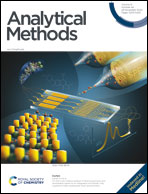A perylene monoimide probe based fluorescent micelle sensor for the selective and sensitive detection of picric acid†
Abstract
A hydroxyl functionalized perylene monoimide probe (PMI-OH) was prepared and self-assembled with the nonionic surfactant Triton X-100 (TX100) to fabricate a fluorescent micelle sensor for the selective and sensitive detection of picric acid (PA), a common explosive and environmental pollutant. The synthesized PMI-OH probe exhibited excimer fluorescence emission, and the intensity of the excimer fluorescence emission was significantly enhanced after the PMI-OH probe formed micelles with TX100. The obtained PMI-OH@TX100 micelles presented excellent photoluminescence properties and had a maximum fluorescence emission at 630 nm. The red fluorescence of the PMI-OH@TX100 micelles was quenched upon introduction of the nitro explosive PA due to electron transfer from the donor (PMI-OH) to the acceptor (PA). The fluorescence quenching of the fluorescent micelle sensor was proportional to the concentration of PA in the range of 2 to 10 μM. The limit of detection was 500 nM using 3σ/k. Thus, the developed PMI-OH@TX100 micelle sensor has great potential to detect PA in ordinary samples.



 Please wait while we load your content...
Please wait while we load your content...